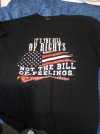In regards to California knife laws-
I've been studying and researching California's knife laws for decades, including the subject of what constitutes a "concealed" fixed-blade (dirk/dagger under California law), unfortunately there has never been a definitive answer from the courts or legislature, there has never been a standard that says "X percentage of the knife must be visible". It basically comes down to
perception and
intent.
It's basically left to the
perception of the cop on the street to decide if a knife is concealed, after all, it's up to them whether or not they arrest you. And then it's up to the
perception of the District Attorney, and then the jury.
But in court the
intent of the person carrying the knife plays a major role is determining if a knife was concealed.
Intent basically comes down to two factors- 1. Is it reasonable to believe that the person carrying the knife was intentionally trying to conceal it from view, and 2. Why was the person carrying the knife in the first place (this is more relevant on the appeals level).
There have been cases in California where a person was carrying a fixed-blade, a cop saw just a part of the knife sticking out from a pocket, or from under a shirt, they were arrested, and despite the fact that the cops
saw the knife they were convicted. Then on appeal their convictions were upheld because the person offered no reason for carrying the knife that the court considered "innocent" (intent), instead the defendants said they were carrying for self-defense (a weapon) which although not illegal by itself, it is not something the California courts consider an "innocent" or legitimate reason for carrying a fixed-blade.
In contrast, there is a case where a man was found to be carrying a fully concealed fixed-blade, found only after he was searched, he was arrested, tried, and convicted, but his conviction was overturned because he successfully convinced the Appeals Court that he was using the knife at work, and forgot he had it in his pocket when he went to lunch. Since the court believed he had no
intent to conceal the knife, and since they believed he had an "innocent" reason for having the knife, the court set him free.
It's all very subjective. Which, in my opinion, makes it all the more important to carry a fixed-blade in such a manner that as much of the knife is visible as possible.
If you ask ten LEO's in California what constitutes a "concealed" fixed-blade you might get ten different answers. The closest California law comes to a definitive statement on the concealed carry of fixed-blades is California penal code 20200, which explains that a knife carried in a sheath, worn openly, is not "concealed" (the blade covered by the sheath does not constitute "concealment"). Here is a link to that statute-
https://www.leginfo.legislature.ca....aySection.xhtml?sectionNum=20200.&lawCode=PEN
I used to carry fixed-blades in leather back-pocket sheaths, but on advice from my attorney I switched to belt-carry, with the knife completely visible from the tip of the handle to the tip of the sheath in order to avoid any possibility of the knife being considered "concealed".

